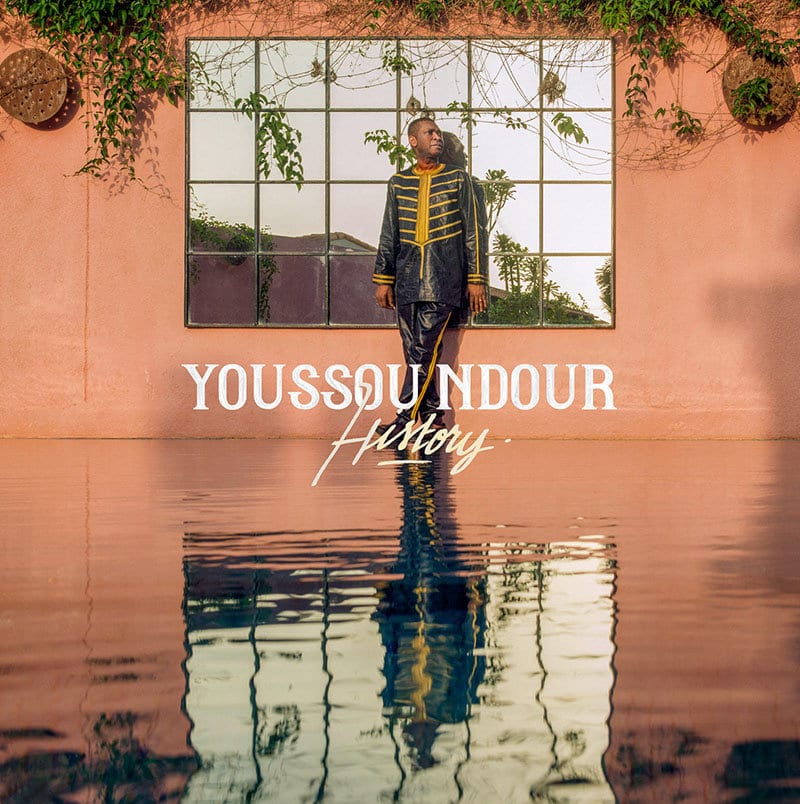
Both in his home country and internationally, Youssou N’Dour has long been the most famous singer from Senegal, even if you don’t know him by name. Not only has he appeared onstage with Peter Gabriel – his golden voice first came to the attention of a wide global audience opening for Peter Gabriel on his tour for So – but he provided the iconic Wolof backing vocals that elevated Gabriel’s hit “In Your Eyes” from pleasant pop song to a thing of beauty.
Youssou N’Dour is an artist with history, to put it mildly. Now, he’s also an artist with History – a brand new album on which N’Dour pays tribute to his past, reflects on the present, and looks to the future on ten lush tracks. There is a natural sweetness to N’Dour’s vocal delivery, and he sings with as much supple grace today as he has for the last three decades. The instrumental color and softness that accompanies him, largely in the form of hand drums, guitars, and sax, complements his dulcet tones well, giving the whole album an effortless feel, though the emotion in his lyrical themes and vocal execution prove his hard work.
N’Dour spends much of History looking back, as the album’s title suggests. He covers two tracks by late, iconic Nigerian master drummer Babatunde Olatunji, “My Child” and “Takuta”, and keeps Olatunji’s weathered voice prominent in the mix, soaring side by side with N’Dour’s. Opening track “Habib Faye” pays tribute to the famed bassist and music director of the same name, who died unexpectedly in 2018 and who, along with N’Dour, pioneered the 1980s Senegalese pop music form mbalax. A bittersweetness pervades this homage, the passion in N’Dour’s delivery set against the serene accompaniment.
At the same time, N’Dour embraces a dynamic sense of the past, bringing two older tracks of his own into the present with fresh arrangements. Originally recorded in 1990, “Ay Coono La” makes good use of sleek modern production in its new form, with clear keys adding a new richness. The “Salimata” of 1989 was sharp and electric; the version on History has more heft and polish.
Central to the gentle glory as N’Dour is, the guests and other personnel featured on History are crucial to note. On many tracks, young Cameroonian saxophone player Alain Rodrigue Oyono shapes a soundscape that is at once nostalgic and current. Other voices take center stage, too. N’Dour accompanies Swedish-Congolese singer Mohombi on a remix of the latter’s purely pop track “Hello” (“I like to keep up with the times,” says N’Dour in the liner notes). More fulfilling is Swedish-Senegambian electrosoul chanteuse Seinabo Sey’s very personal take on N’Dour’s track “Birima”. Though each artist’s part has a slightly different approach, both use their time together to honor a shared West African heritage – “Whoa, Africa / I’m gonna give you, give you all my love,” sings N’Dour in English.
The songs on History are great, the arrangements lovely, if occasionally a little overly slick. The guest list is impressive, and the stylistic variety N’Dour curates impeccable. More than that, though, is one key intangible: N’Dour’s soul. It comes through in the care with which he puts together an album, and, of course, it comes through in his unmistakable voice, stable and melismatic, a joy to listen to from the simple melody of opener “Habib Faye” to the last chorus of trilingual closing track “Tell Me”. A song that might seem bland in another singer’s repertoire comes to life in N’Dour’s, and on History, every track thrives as N’Dour glides along with the connections between his past and present, making them ready to share with any contemporary audience.

